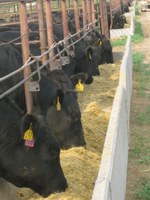Wheat Straw Can Help Keep Cows Full
(Click the image below to view a high-resolution image that can be downloaded)
Cattle producers should consider feeding wheat straw to keep cows full and prepared for winter, according to a North Dakota State University Extension livestock expert.
“Cows, as large ruminants, need a lot of feed to fill them up and keep them full,” says John Dhuyvetter, Extension livestock systems specialist at the North Central Research Extension Center near Minot, N.D.
“As roughage in the rumen ferments and breaks down, heat is produced, which helps provide contentment in cold weather, and digestible nutrients are made available to meet the nutritional needs of the cow for maintenance and gestation,” he explains. “When feed consumed provides nutrients above these needs, it will be stored as fat or used for weight gain.”
On a dry-matter basis, a cow may be able to consume low-quality fibrous, slow-to-break-down roughage equal to only 2 percent of her body weight per day. That is unlikely to provide her with adequate nutrition and result in weight loss. However, high-quality forages break down and pass through the body quite fast. These forages can be associated with intakes up to 4 percent of body weight.
“If your feeding situation involves high-quality, nutrient-rich feeds such as early cut legume mixed hay, silage or grain products, a cow’s nutrient needs may be met in a quantity of feed less than what she has the appetite and ability to consume,” Dhuyvetter says. “Being unnecessary and way too costly to let her fill up on expensive feeds, provide a low-cost residue feed such as wheat straw to help keep her full and prepared for cold weather.”
How much straw a producer should blend into the ration will vary based on cow needs and other feeds used. As an example, a 1,400-pound cow in moderate condition could be fed 30 pounds of silage, 8 pounds of alfalfa hay and 15 pounds of straw.
“With typical feed analysis values, your cow will be receiving an 8.5 percent crude protein and 54 percent total digestible nutrients ration,” Dhuyvetter says. “With normal weather and minimal waste, she should put on a few pounds in midgestation and maintain in late gestation.”
He adds: “Testing feeds for nutritional value with the aid of a ration-evaluating computer app and advice from a feed consultant or nutritionist will help ensure an economical and on-target feeding strategy.”
Contact Dhuyvetter at 701-857-7682 or john.dhuyvetter@ndsu.edu for more information.
NDSU Agriculture Communication - Dec. 26, 2018
| Source: | John Dhuyvetter, 701-857-7682, john.dhuyvetter@ndsu.edu |
|---|---|
| Editor: | Ellen Crawford, 701-231-5391, ellen.crawford@ndsu.edu |


